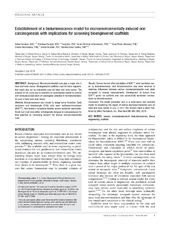| dc.contributor.author | Suliman, Salwa | en_US |
| dc.contributor.author | Parajuli, Himalaya | en_US |
| dc.contributor.author | Sun, Yang | en_US |
| dc.contributor.author | Johannessen, Anne Christine | en_US |
| dc.contributor.author | Finne-Wistrand, Anna | en_US |
| dc.contributor.author | McCormack, Emmet | en_US |
| dc.contributor.author | Mustafa, Kamal Babikeir Eln | en_US |
| dc.contributor.author | Costea, Daniela Elena | en_US |
| dc.date.accessioned | 2016-03-21T13:56:40Z | |
| dc.date.available | 2016-03-21T13:56:40Z | |
| dc.date.issued | 2015 | |
| dc.Published | Head and Neck 2015 | eng |
| dc.identifier.issn | 1043-3074 | |
| dc.identifier.uri | https://hdl.handle.net/1956/11721 | |
| dc.description.abstract | Background: Microenvironmental cues play a major role in head and neck cancer. Biodegradable scaffolds used for bone regeneration might also act as stimulative cues for head and neck cancer. The purpose of this study was to establish an experimental model for precise and noninvasive evaluation of tumorigenic potential of microenvironmental cues in head and neck cancer. Methods: Bioluminescence was chosen to image tumor formation. Early neoplastic oral keratinocyte (DOK) cells were luciferase-transduced (DOKLuc), then tested in nonobese diabetic severe combined immunodeficient IL2rγnull mice either orthotopically (tongue) or subcutaneously for their potential as “screening sensors” for diverse microenvironmental cues. Results: Tumors formed after inoculation of DOKLuc were monitored easier by bioluminescence, and bioluminescence was more sensitive in detecting differences between various microenvironmental cues when compared to manual measurements. Development of tumors from DOKLuc grown on scaffolds was also successfully monitored noninvasively by bioluminescence. Conclusion: The model presented here is a noninvasive and sensitive model for monitoring the impact of various microenvironmental cues on head and neck cancer in vivo. | en_US |
| dc.language.iso | eng | eng |
| dc.publisher | Wiley | eng |
| dc.relation.ispartof | <a href="http://hdl.handle.net/1956/11916" target="blank">Bioactive copolymer scaffolds for bone tissue engineering. Efficacy and host response</a> | eng |
| dc.relation.ispartof | <a href="http://hdl.handle.net/1956/11974" target="blank">Role of integrin a11 in oral carcinogenesis. In vitro and in vivo studies</a> | eng |
| dc.rights | Attribution CC BY-NC-ND 4.0 | eng |
| dc.rights.uri | http://creativecommons.org/licenses/by-nc-nd/4.0/ | eng |
| dc.subject | Cancer | eng |
| dc.subject | microenvironment | eng |
| dc.subject | bioluminescence | eng |
| dc.subject | tissue engineering | eng |
| dc.subject | scaffold | eng |
| dc.title | Establishment of a bioluminescence model for microenvironmentally induced oral carcinogenesis with implications for screening bioengineered scaffolds. | en_US |
| dc.type | Peer reviewed | |
| dc.type | Journal article | |
| dc.date.updated | 2016-02-04T13:46:34Z | |
| dc.description.version | publishedVersion | en_US |
| dc.rights.holder | Copyright 2015 The Authors | |
| dc.identifier.doi | https://doi.org/10.1002/hed.24187 | |
| dc.identifier.cristin | 1329788 | |

